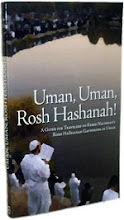by Dovid Sears
In Likutey Moharan I, 65, Rebbe Nachman compares
reciting the words of prayer to gathering flowers into a bouquet. But as each
new word-flower is added, the previous one begs, “Don’t forget me!” Thus, Rebbe
Nachman states, the baal tefilah, the person who is praying, must “make echad”
(literally, “one”) of them all. He must remember the first letter of the first
word even when he has reached the last letter of the last word.
What does this
mean? And how are we to accomplish this?
Rebbe Nachman’s
conundrum is not unlike a zen koan (although he’s discussing davening,
which is a koan of a different color). His call for us to “make echad”
out of a sequential, linear process seems to defy common-sense logic, while
seeking to wake us up from what the kabbalists call “mochin di-katnus,”
or “constricted consciousness.”
Perhaps this
teaching may be understood in the light of a medieval prayer manual written by the Spanish
kabbalist Rabbi Azriel of Gerona, the main disciple of Rabbi Yitzchak
Sagi-Nahor (“Isaac the Blind”), who taught the secrets of the Kabbalah to the illustrious
RaMBaN (Rabbi Moshe ben Nachman). In his Sod haTefilah (“Secret of
Prayer”) (pp. 215-216), Rabbi Azriel states: “One who prays must push aside
every hindrance and barrier and restore each word to its ‘nothingness.’ ”
This
“nothingness” is not meant in a negative sense, but rather describes the
indefinable essence of all manifestation. Read the word as “no-thingness.”
According to
Rabbi Azriel, a proper prayer is one in which “we have directed the words to
the ‘nothingness of the word.’ ”
Although we walk
in the multiplicity of the material world, he explains that we exist on a
higher plane as well: “One who ascends from the ‘Form of Forms’ [i.e., manifestation
on the lowest plane of existence] to the ‘Root of Roots’ [i.e., the essence of
all existence] must gather together the multiplicity—for the Root extends
through every form that arises from it at any time. Even when the forms are
destroyed, the Root is not destroyed.”
Note the
similarity to Rebbe Nachman’s description of prayer as a gathering of the
separate words into “echad.”
This “Root of
Roots” is also related to memory, as Rebbe Nachman states in Likutey Moharan
I, 54. There, he speaks of “constantly remembering the World to Come (lizkor
tamid be-alma de-asi)”—a provocative and characteristically Breslov oxymoron
meaning to recall the primordial unity from which all multiplicity and form
devolves. That is, the goal of creation restores the “forgotten” sublime reality
from which all creation has come forth. Hence, remembering the words of prayer
is not an act of remembering in the ordinary sense (which would leave most of
us in despair, which Rebbe Nachman severely censures), but a heightened cognizance
of their point of origin within that primordial unity.
Thus, in Rebbe
Nachman’s view, prayer is both an act of gathering and of spiritual elevation,
accomplished by connecting each word to the “Root of Roots.” This is its
essential “nothingness”— its point of origin in the dimension that is beyond
all form and multiplicity. With this kavanah (intention), one “makes echad”
of the words.
This unity is
what he calls the “takhlis,” the ultimate goal—which is the Ultimate Reality.
As Rebbe Nachman states at the end of Torah 65: “ ‘Do not go to glean in
another field…’ (Ruth 2:8)—because all the letters are precious gleanings
gathered together from the supernal fields (as explained earlier in the
lesson). Each utterance begs the soul not to leave it behind to gather other
gleanings. But this is impossible, since one must go and gather more. However,
[the verse continues] “…and do not pass from here”—that is, even when you go on
to another word, do not pass the first word. This is accomplished by focusing
on the Ultimate Reality (takhlis).”
This intentionality
during prayer brings about a sort of “cosmic consciousness,” in that the underlying
unity of all separate elements is perceived.
As Rebbe Nachman
states (Torah 65, section 2): “This is the basic principle: it is necessary to
combine the entire prayer into one (echad). In each word that one
speaks, all the words of the prayer as a whole should be present. From the
beginning of the prayer until its end, everything should be one, so that when
one stands at the last word, he will be standing at the first word of the
prayer simultaneously. Thus, one will be able to pray the entire prayer, and
still not depart from even the first letter.”
Let’s take a
closer look at this as it applies to actual practice. Rebbe Nachman’s
great-grandfather, the Baal Shem Tov (Rabbi Yisrael ben Eliezer, 1698-1760),
had much to say about prayer. One of his well-known teachings is: “Deveykus
(mystical cleaving) means that when one utters a word [of prayer], he draws it
out at length—for due to his cleaving, he doesn’t want to part from the word.
Therefore, he draws out its pronunciation” (Tzava’as HaRivash 70).
This description
of prayer sounds much like Rebbe Nachman’s teaching about how each word begs, “Don’t
forget me!” (although the Baal Shem Tov’s remark about deveykus reflects
the standpoint of the speaker). This is consistent with the way Rabbi Nachman
describes praying with attentiveness in the same lesson we have been discussing.
Toward the end
of section 4, Rebbe Nachman defines praying with kavanah as “hearing the
words that you bring forth from your mouth.” He explains that one’s own words
are truly the words of the Shekhinah, coming forth from the soul—which
is a portion of the Shekhinah. As the Baal Shem Tov similarly taught,
“The soul is the life-force. Thus, when it departs, one no longer feels any
bodily sensation; this life-force is actually one with the Source of all life
and all creatures: the Holy Blessed One” (Degel Machaneh Ephraim, Bechukosai).
The Shekhinah
produces the words of prayer, and the words, too, are part of the Shekhinah.
If so, how could our words of prayer ever be lost?
Maybe all we need
to do, in the midst of saying them, is simply to realize this.















No comments:
Post a Comment